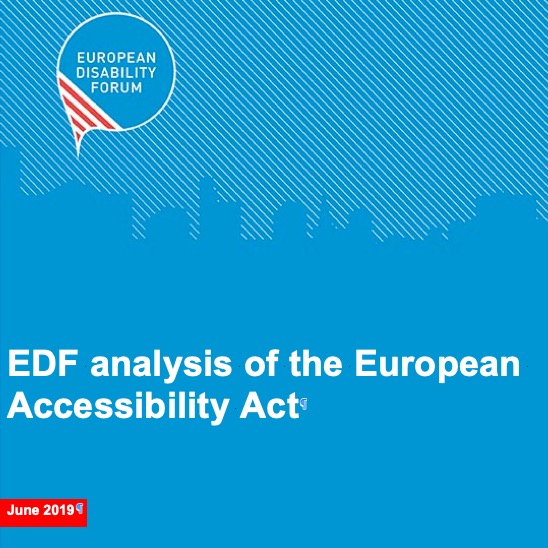European Disability Forum Analysis of the European Accessibility Act
Share on social media
7 June 2019. The Act was published today in the Official Journal of the EU. Discover what products are covered and the Act’s strengths and weaknesses in EDF’s analysis.
 7 June 2019. The European Accessibility Act was published today in the Official Journal of the EU.
7 June 2019. The European Accessibility Act was published today in the Official Journal of the EU.
Here the European Disability Forum (EDF) presents the business sectors, which products are covered and an analysis of the Act’s strengths and weaknesses.
Read EDF's report for a full overview and to discover products and services included on the Act.
Short summary of strengths and shortcomings of the Accessibility Act
The Act has a number of strengths, for example:
- Accessibility requirements for the products and services included in the Act are mandatory for public procurement.
- For products and services not included in the Act, the Directive provides a list of accessibility requirements that can help to demonstrate compliance with accessibility provisions laid down in present and future EU laws (e.g. EU funds regulations).
- Economic operators are obliged to take immediate corrective measures, or withdraw, if a product doesn’t meet the accessibility requirements of the Act.
- If one Member State withdraws an inaccessible product from the market the others must follow suit.
- Market Surveillance Authorities are given a prominent role and NGOs, national authorities or other bodies can represent individuals in court under national law.
- The European Commission can adopt additional measures complementing the accessibility requirements and provisions of the Act.
- Finally, it is highly welcome that Disabled Persons’ Organisations will work with national authorities, other stakeholders, and the European Commission to advise them during the implementation of the Act. They will also be involved in future reviews of the Act.
However, there are ways in which the Act fell short of our expectations:
- The scope of services and products it covers is very limited. Health care services, education, transport, housing, and household appliances were left out of the Act.
- A number of exemptions are made even in case of products and services covered by the Act. For example, when the service is related to urban, suburban and regional transport or is provided by a microenterprise, it is exempt from the requirements of the Act.
- Requirements concerning the built environment related to the services covered by the Act are left to the decision of Member States.
- There are provisions that allows further exemptions based on a fundamental alteration of the product or service, or because of a disproportionate burden for the economic operator.It is also unfortunate that the robust enforcement mechanism of litigation, i.e. going to court on behalf of an individual under national law, does not apply to infringement cases made by public authorities.
- The period of transposition by Member States is lengthy and for some of the products and services implementation is disproportionally long.
For more information, please contact:
Mher Hakobyan (he/him)
Accessibility Officer
tel + 32 2 282 46 06
Email: mher.hakobyan@edf-feph.org
Web: www.edf-feph.org
Download EDF's Report on the EEA in PDF format from the right-hand panel.
European Accessibility Act Official Text in ENAT Library.
